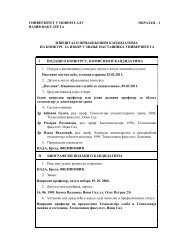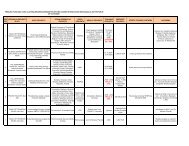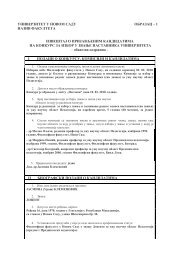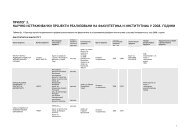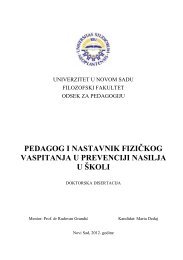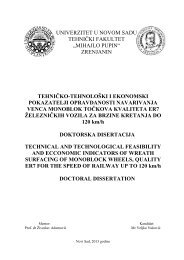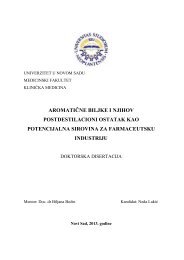Intercultural competence as an aspect of the communicative ...
Intercultural competence as an aspect of the communicative ...
Intercultural competence as an aspect of the communicative ...
You also want an ePaper? Increase the reach of your titles
YUMPU automatically turns print PDFs into web optimized ePapers that Google loves.
argued forcefully for <strong>the</strong> integration <strong>of</strong> cultural knowledge <strong>an</strong>d intercultural <strong>competence</strong><br />
into <strong>the</strong> foreign l<strong>an</strong>guage curriculum’ (Schulz 2007: 10). Consequently, <strong>the</strong>re h<strong>as</strong> been a<br />
number <strong>of</strong> approaches for integrating culture in l<strong>an</strong>guage teaching (e.g., Byram, Zarate<br />
1997; Crawford-L<strong>an</strong>ge, L<strong>an</strong>ge 1984; DeCapua, Wintergerst 2004; Kramsch 1993, Seelye<br />
1993). Yet, <strong>the</strong>re h<strong>as</strong> not been <strong>an</strong>y consensus <strong>as</strong> to how culture should be ‘defined<br />
operationally’ (Schulz 2007: 10) in foreign l<strong>an</strong>guage learning when it comes to objectives<br />
<strong>an</strong>d <strong>as</strong>sessment. The sheer v<strong>as</strong>tness <strong>of</strong> culture makes it impossible to tell <strong>the</strong> learner<br />
everything <strong>the</strong>y need to know about <strong>the</strong> target culture.<br />
The view that culture is ‘everything […] is precisely what makes <strong>the</strong> concept <strong>of</strong><br />
culture nearly unm<strong>an</strong>ageable’ (Morill<strong>as</strong> 2001: 297). A more realistic goal is to attune<br />
(Corbett 2003) learners to <strong>the</strong> possibility <strong>of</strong> difference, <strong>an</strong>d explore how ‘decentring from<br />
one’s own taken-for-gr<strong>an</strong>ted world c<strong>an</strong> be structured systematically in <strong>the</strong> cl<strong>as</strong>sroom’<br />
(Byram, Fleming 1998: 7) <strong>an</strong>d in that way create a ‘sphere <strong>of</strong> interculturality’ (Kramsch<br />
1993). Culture learning should be ‘<strong>the</strong> process <strong>of</strong> acquiring <strong>the</strong> culture-specific <strong>an</strong>d<br />
culture-general knowledge, skills, <strong>an</strong>d attitudes required for effective communication <strong>an</strong>d<br />
interaction with individuals from o<strong>the</strong>r cultures [engaging] <strong>the</strong> learner cognitively,<br />
behaviorally, <strong>an</strong>d affectively’ (Paige et al. 2003: 177). There should be ‘a systematic<br />
framework for teaching culture <strong>an</strong>d l<strong>an</strong>guage toge<strong>the</strong>r, in which <strong>the</strong> relationship between<br />
<strong>the</strong>m is explicitly explored with learners’ (Baker 2011: 4). This view <strong>of</strong> culture learning<br />
shows that <strong>the</strong>re h<strong>as</strong> been a shift in perspective <strong>of</strong> culture learning. From <strong>an</strong> additional<br />
l<strong>an</strong>guage skill, learning <strong>of</strong> facts <strong>an</strong>d information, culture now h<strong>as</strong> more import<strong>an</strong>ce in<br />
terms <strong>of</strong> learning objectives <strong>an</strong>d outcomes. This is also a step away from <strong>the</strong> ethnocentric<br />
approach ‘which focuses on mech<strong>an</strong>ical communication beyond which learners retain<br />
<strong>the</strong>ir own system <strong>of</strong> thought <strong>an</strong>d perception <strong>of</strong> <strong>the</strong> world’ (Geoghe<strong>an</strong> 2010: 144).<br />
Liddicoat et al. (2003) also claim that l<strong>an</strong>guage <strong>an</strong>d culture interact with each<br />
o<strong>the</strong>r in a way that culture connects to all levels <strong>of</strong> l<strong>an</strong>guage use <strong>an</strong>d structures; i.e. <strong>the</strong>re<br />
is no level <strong>of</strong> l<strong>an</strong>guage which is independent <strong>of</strong> culture. The interconnection <strong>of</strong> l<strong>an</strong>guage<br />
<strong>an</strong>d culture is import<strong>an</strong>t for l<strong>an</strong>guage learning (Figure 2.1), <strong>as</strong> culture should be included<br />
in all <strong>as</strong>pects <strong>of</strong> l<strong>an</strong>guage learning – from general text structures to prosody <strong>an</strong>d kinesics.<br />
As a consequence, learners would not be ‘fluent fools’ (Bennett 1997), <strong>as</strong> ‘without<br />
cultural insight <strong>an</strong>d skills, even fluent speakers c<strong>an</strong> seriously misinterpret <strong>the</strong> messages<br />
<strong>the</strong>y hear <strong>of</strong> read, <strong>an</strong>d <strong>the</strong> messages <strong>the</strong>y intend to communicate c<strong>an</strong> be misunderstood’<br />
(Pesola 1991: 331).<br />
30



